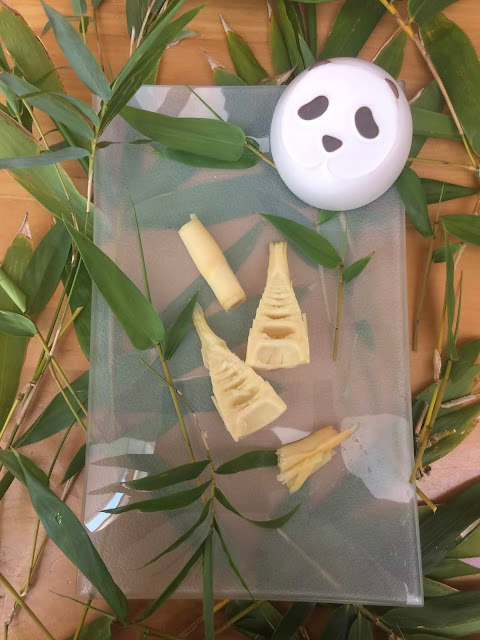I have bamboo growing in the driveway, which is beautiful but also invasive and we keep it under strict control, by cutting and.... eating. Every now and then my neighbour bring me big shoot (already about 1m high) which is great, but I much prefer the small and tender shoot so I check the driveway early in the morning for signs of shoots like the one picture above (bottom right). If you leave it to the afternoon it would shoot up in no time!!
I started cooking bamboo shoots when I was living in Japan, they were a different kind, much 'fatter' but these are good too, better than buying canned bamboo! Peel off the outer green layers, then cut into slices (I also like to cut the tips into two to see the layers), and discard the hard nodes. Rinse and cook for about 20 minutes in the water left over from rinsing rice (or add a little rice bran to your cooking water, I don't have rice bran so I keep the rice rinsing water), a pinch of salt and a chili (optional, but apparently it takes away the bitterness). 20 minutes suffice for small tender shoots, but if you have longer ones just make sure that you can pierce them with a knife or leave 5 minutes longer. If not using immediately store in lightly salted water.
Fresh bamboo is tasty by itself, or can be added to a variety of Asian dishes. Usually I have it with rice and other veggies in a Japanese meal, in a stir fry or a coconut 'curry'.
For this curry I fried a shallot with a little vegetable oil, then added one can of coconut cream, 500 ml of vegetable stock, 1 tsp each of Fresh As Kaffir lime powder, ginger powder, sweet basil powder, coriander powder and lemon grass powder, plus a bit of turmeric, and chili flakes, a couple of carrots, green beans, dried mushrooms (pre-soaked) Tofu and my cooked bamboo. At the end of cooking I also added fresh Vietnamese mint, basi, young broccoli leaves and, just before serving, marigold flowers and young Nasturtium leaves.
Photos and Recipes by Alessandra Zecchini ©
























